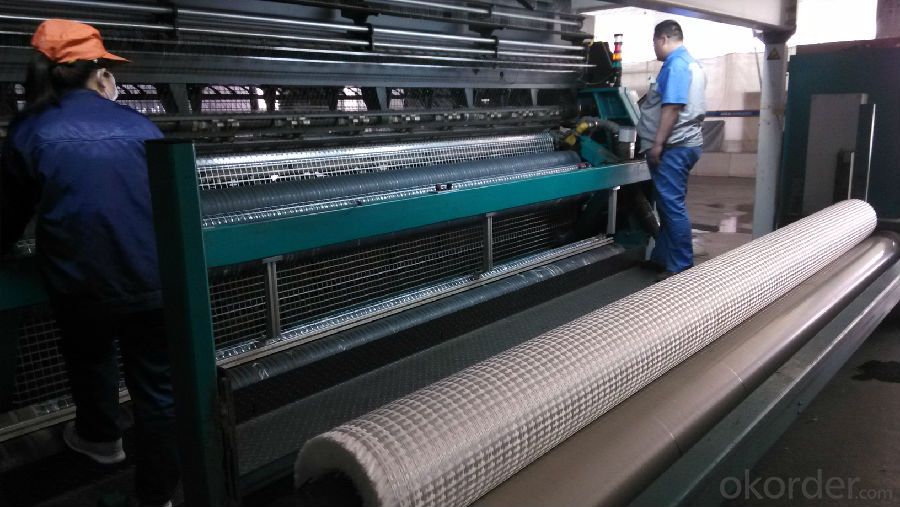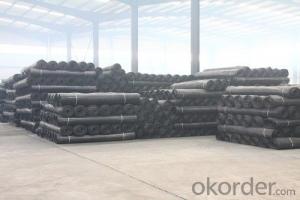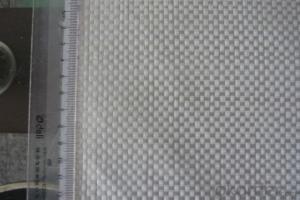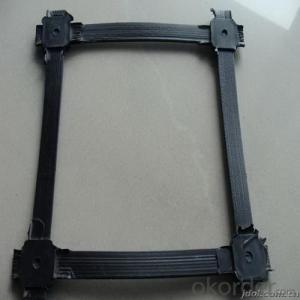Fiberglass geogrid for River Bank- Hot sell
- Loading Port:
- Qingdao
- Payment Terms:
- TT OR LC
- Min Order Qty:
- 1000 m²
- Supply Capability:
- 1000000 m²/month
OKorder Service Pledge
OKorder Financial Service
You Might Also Like
1.Brief Introduction
Product has high strength, low elongation, high temperature, high modulus , light weight , good toughness, corrosion resistance , long life , etc. , can be widely used in the old concrete pavement , maintenance of airport runways , dams , river banks , while slope protection , road bridge , enhancement engineering field, to the road surface can be enhanced , reinforced to prevent pavement rutting fatigue crack , hot and cold telescopic cracks and reflection cracks below , and can the pavement load stress dispersion , extending pavement life .
2.Characteristics
The high tensile strength low - elongation : Fiberglass geogrid is a glass fiber , while the high tensile strength of glass fiber , more than other fibers and ordinary metals . Its high modulus , high resistance to deformation , elongation at break of less than 3% .
No long-term creep : as a reinforcing material , with the ability to resist deformation under the load in the long-term creep resistance is extremely important, the glass fiber will not creep , to ensure that the products can long-term performance .
3.Application
ysical and chemical stability after special treatment agent coated handle , fiberglass geogrid to resist a variety of physical wear and chemical attack , but also to resist biological erosion and climate change to ensure that its performance is unaffected by the loss .
4.FAQ
good thermal stability : the melting point of glass fibers is above 1000 °C , to ensure the stability of the glass fiber geogrids to withstand high temperature in a paving job .

- Q:What are the different fiberglass fabric finishes for fire resistance?
- Fire resistance in fiberglass fabrics can be achieved through several different finishes. One popular option involves using a silicone coating, which effectively resists flames and high temperatures. By forming a protective barrier on the fabric, this coating prevents flames from spreading and reduces the risk of ignition. Another commonly used finish is acrylic coating, which also boasts good fire resistance properties. This type of coating establishes a flame-retardant barrier capable of withstanding high temperatures and preventing the fabric from catching fire. Additionally, some fiberglass fabrics may incorporate a vermiculite coating, a mineral-based finish that expands when exposed to heat. In doing so, it creates a thermal barrier, insulating the fabric and delaying the spread of flames. Furthermore, manufacturers may provide fiberglass fabrics with a PTFE (polytetrafluoroethylene) coating, renowned for its exceptional heat resistance. These coatings can endure extremely high temperatures, offering a durable fire-resistant finish. The availability of these various fiberglass fabric finishes for fire resistance ensures different levels of protection, making them suitable for various applications based on specific requirements and regulations.
- Q:What are the different printing options available for fiberglass fabric?
- There are several printing options available for fiberglass fabric, including digital printing, screen printing, and heat transfer printing. Digital printing allows for detailed and complex designs to be directly printed onto the fabric using specialized printers. Screen printing involves pushing ink through a mesh stencil onto the fabric, creating vibrant and long-lasting prints. Heat transfer printing utilizes heat and pressure to transfer a design from a special paper onto the fabric, resulting in durable and high-quality prints. These different printing options offer flexibility and versatility in creating customized and visually appealing designs on fiberglass fabric.
- Q:Is fiberglass fabric resistant to pests in agricultural settings?
- Yes, fiberglass fabric is generally resistant to pests in agricultural settings. Its non-porous and smooth surface makes it difficult for pests to chew through or attach to, making it an effective barrier against common agricultural pests such as rodents, insects, and birds. Additionally, fiberglass fabric is not susceptible to rot or decay, further preventing pest infestations.
- Q:Can fiberglass fabric be used for reinforcement in plastic tanks?
- Yes, fiberglass fabric can be used for reinforcement in plastic tanks. Fiberglass fabric is known for its high strength and durability, making it an ideal material for reinforcing various structures, including plastic tanks. The fabric can be applied to the surface of the tank during the manufacturing process or as a retrofit solution for existing tanks that require additional strength. The fiberglass fabric helps to increase the structural integrity and resistance to external forces, such as pressure or impacts, ensuring the tank can withstand the necessary loads and maintain its shape over time. Additionally, fiberglass fabric is resistant to corrosion, which is especially beneficial for tanks that store corrosive substances. Overall, fiberglass fabric is a reliable and cost-effective solution for reinforcing plastic tanks.
- Q:Are there any health risks associated with exposure to fiberglass fabrics?
- Yes, there are potential health risks associated with exposure to fiberglass fabrics. Fiberglass is made of tiny fibers that can become airborne when disturbed, and if inhaled, these fibers can irritate the respiratory system, causing lung irritation, coughing, and shortness of breath. Prolonged exposure to fiberglass can also lead to more serious health issues such as lung scarring and fibrosis. It is important to take proper safety precautions, such as wearing protective clothing and masks, when working with or around fiberglass fabrics to minimize the risk of health problems.
- Q:Can fiberglass fabric be used for making conveyor belts or hoses?
- Yes, fiberglass fabric can be used for making conveyor belts or hoses. It is known for its high strength-to-weight ratio, heat resistance, and durability, which makes it suitable for various industrial applications, including conveyor belts and hoses.
- Q:Are fiberglass fabrics resistant to shrinkage or stretching?
- Fiberglass fabrics possess remarkable resistance against shrinkage and stretching, owing to the inherent qualities of fiberglass such as its impressive tensile strength and minimal elasticity. As a result, these fabrics prove highly resilient to both shrinkage and stretching, making them ideal for situations where dimensional stability is crucial. This includes their application in the production of industrial products, insulation materials, and composite materials. Moreover, due to their durability and resistance against shrinkage and stretching, fiberglass fabrics are well-suited for usage in high-temperature environments and adverse conditions. In conclusion, fiberglass fabrics provide outstanding stability and retain their shape and size even when subjected to diverse external forces.
- Q:Is fiberglass fabric resistant to rodents?
- Yes, fiberglass fabric is generally resistant to rodents. Its composition and texture make it unattractive and difficult for rodents to chew through or nest in.
- Q:Can fiberglass fabric be used for gaskets and seals?
- Certainly, gaskets and seals can be made using fiberglass fabric. Renowned for its ability to withstand high temperatures, durability, and exceptional insulation properties, fiberglass fabric is an ideal material for manufacturing gaskets and seals across a range of industries such as automotive, aerospace, industrial, and marine. By utilizing this fabric, one can fashion customized gaskets and seals that possess a snug and secure fit, effectively averting any fluid or gas leakage. Moreover, fiberglass fabric exhibits remarkable resilience when confronted with harsh chemical conditions, rendering it a dependable option for gaskets and seals that must endure exposure to corrosive substances.
- Q:Rural cement flat roof room, how to do waterproof, anti leakage best?
- (1) laying flexible waterproof layer, choose coating or coil can. The construction conditions require that the moisture content of the base surface is not greater than 9%, so it is suitable for construction in the summer after 5 days of hot weather. After completion, water storage experiments should be carried out;(2) such as waterproof coating, a coated cloth two "for example: clean up the grass, full of paint, dry film, laying a layer of glass fiber cloth reinforced matrix materials, and in the exhibition has fixed full brush a layer of paint on the surface, drying after construction paint. The overall thickness of waterproof coating should be more than 3 millimeters;(3) if the construction of waterproof coiled material is done, after cleaning the base, glue the adhesive on the back of the coil and the base, and press and close the base line according to the good benchmark, and finally do the inspection of the seam joint.
1. Manufacturer Overview |
|
|---|---|
| Location | |
| Year Established | |
| Annual Output Value | |
| Main Markets | |
| Company Certifications | |
2. Manufacturer Certificates |
|
|---|---|
| a) Certification Name | |
| Range | |
| Reference | |
| Validity Period | |
3. Manufacturer Capability |
|
|---|---|
| a)Trade Capacity | |
| Nearest Port | |
| Export Percentage | |
| No.of Employees in Trade Department | |
| Language Spoken: | |
| b)Factory Information | |
| Factory Size: | |
| No. of Production Lines | |
| Contract Manufacturing | |
| Product Price Range | |
Send your message to us
Fiberglass geogrid for River Bank- Hot sell
- Loading Port:
- Qingdao
- Payment Terms:
- TT OR LC
- Min Order Qty:
- 1000 m²
- Supply Capability:
- 1000000 m²/month
OKorder Service Pledge
OKorder Financial Service
Similar products
New products
Hot products
Hot Searches
Related keywords




























